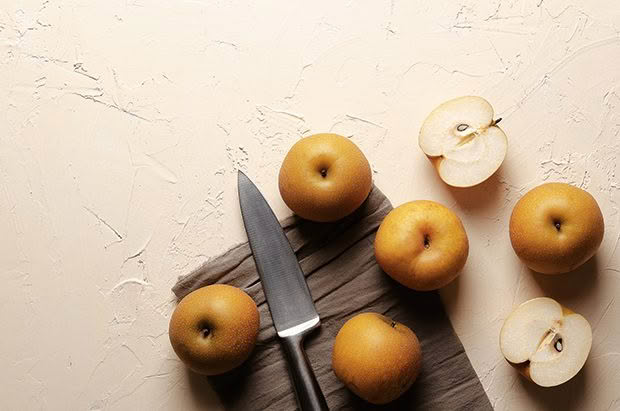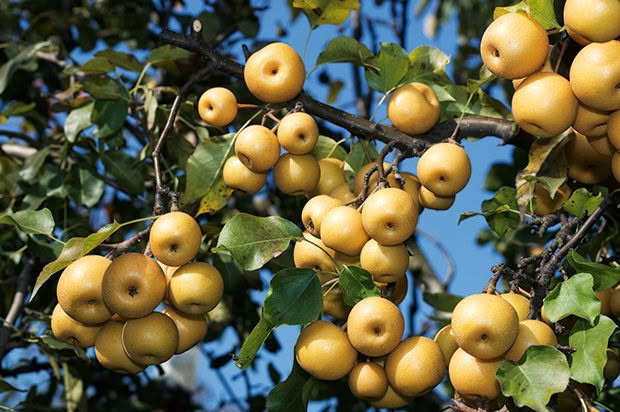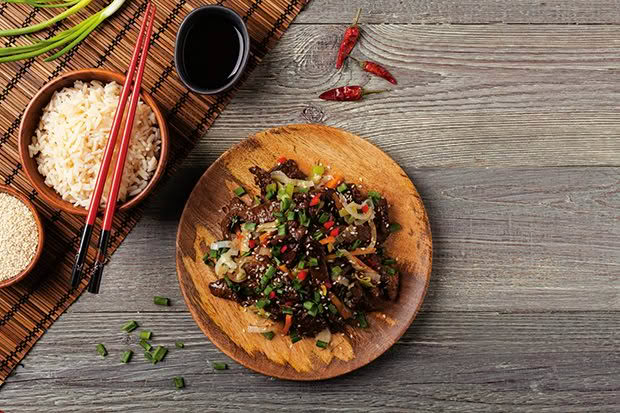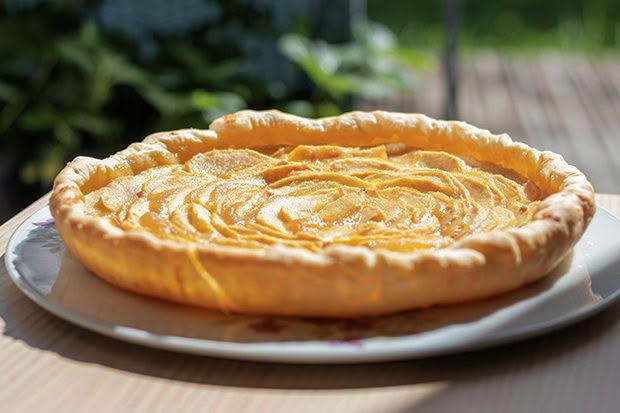Why you should add more nashi pears into your meals

Whether you add it to a fruit salad, or use it to tenderise your steak, nashi is a great addition to every garden and kitchen.
Words: Jenny Garing
There’s a nashi tree on our property that bears an extraordinary amount of fruit every year, even though we do nothing to it. Despite the wet summer – or maybe because of it – the tree has grown especially well in recent months, giving us a wonderful supply of delicious, versatile fruit.
Although they’re both referred to as Asian pears in New Zealand, nashi (Pyrus pyrifolia) is different from the Chinese pear (Pyrus bretschneideri) – sometimes called ya pear. The ya pear is more the bell shape and smooth texture of the European pear, while nashi are round with a coarse, brownish skin. They are superb eating fruit with crisp, grainy texture and wonderfully juicy, apple-like flavour. I have fond memories of living in Japan and Korea where huge nashi pears were slowly peeled, cored and sliced, and then eaten with a dainty little fork after dinner. It was such a refreshing way to finish a meal. Although the fruit on our tree is nowhere near as big as the ones in Japan, they are just as tasty and refreshing.

Nashi are best eaten slightly chilled and are marvellous in fruit salads, especially Asian-style fruit salads like the Malaysian rojak. For a savoury take, they can be grated and added to coleslaws or shaved vegetable salads. Chef Peter Gordon makes a savoury salsa with kiwifruit and nashi, flavoured with lime and basil to serve with salmon. Like European pears, nashi can complement a good blue or other type of sharp cheese, or can be paired with cooked haloumi and almonds. In Korea, nashi are most commonly used to tenderise meat such as pork, beef ribs, beef cuts for stews, or to marinade stir fry beef.
If you’re lucky enough to have nashi growing on your property, the following three recipes – sweet, savoury and sour – from around the globe are a great way to highlight the fruit’s versatility.
Bulgogi

My Korean friend, So Young, taught me how to make bulgogi, a traditional stir-fried beef dish in Korea. The nashi is necessary for both tenderising and flavouring the meat. When I didn’t have nashi, she refused to make it.
The word bulgogi translates as fire meat due to the process of cooking thin slices of meat on a grill or BBQ. The dish can be prepared in two different ways: grilling the meat by itself and eating in a lettuce or shiso leaf, or cooking the meat with some vegetables to serve with rice as a main meal.
Prep Time: 15 minutes plus 4 hours marinating
Cook Time: 10 minutes
Serves: 4-6
INGREDIENTS
800g rib eye (or any tender prime beef cut), thinly sliced, 2mm to 3mm thickness
1 tbsp toasted sesame oil
1 onion, peeled and thinly sliced
2 spring onions, thinly sliced on the angle
½ carrot peeled and thinly sliced
1 tbsp toasted sesame seeds
1 tbsp rice bran oil
1 red chilli, chopped, for garnish (optional)
Marinade:
6 tbsp soy sauce
3 tbsp brown sugar
2 tbsp rice wine (or mirin)
1 nashi, chopped
½ onion, chopped
1 tbsp minced garlic
1 tsp minced ginger
½ tsp ground black pepper
METHOD
Blend the marinade ingredients in a mixer or food processor until smooth.
Place the thinly sliced meat in a mixing bowl and pour the marinade over it.
Gently massage the marinade into the meat with your hands. Add the sesame oil into the mixture.
Cover the bowl with beeswax wrap and marinate the meat for at least 4 hours in the fridge. (If you have more time, you can also marinate it overnight to deepen the flavour.)
Preheat a frying pan/bbq grill on medium-high heat. Pour in the rice bran oil. Add the vegetables and cook for 2 minutes, then add the meat and cook on medium-high heat for 3-5 minutes, until the meat is done.
Toss in the sesame seeds and stir them in quickly. Serve the bulgogi with steamed rice.
Nashi Ginger Tart

Prep time: 15 minutes
Cook time: 15-20 minutes
Serves: 6
INGREDIENTS
1 sheet frozen puff pastry
2 nashi, sliced thinly
3 tbsp grated ginger
3 tbsp brown sugar
1 tsp vanilla extract
1 tsp ground cinnamon
3 tbsp olive oil
METHOD
Preheat your oven to 200°C. In a bowl, use a fork to whisk together the cinnamon, vanilla extract, two tablespoons of sugar, grated ginger and olive oil.
Lay out the pastry on a baking tray and fold up the edges to form a barrier. Spread half the ginger mix over the pastry base. Lay the slices of nashi on top in rows with the slices overlapping tightly. Spread the rest of the ginger mix on top of the nashi and then sprinkle with the remaining sugar. Bake for 15-20 minutes, until the pastry is cooked and the nashi is soft. Serve with cream.
Ottoman Sherbet

This is a homemade version of the kind of sherbet that I used to buy in the streets of Turkey. It’s a fermented, gut-friendly drink that’s also very hydrating. Usually made with fruits such as plums, cherries and some tamarind, my version with nashi is flavourful but not too intense.
Prep Time: 15 minutes plus 10 days fermenting
Serves: 6-8
INGREDIENTS
1 red apple
1 granny smith (or sour green) apple
2 nashi
100g green grapes
200g firm red plums
50g red grapes
1 cinnamon stick
2 cloves
220g sugar
5 chickpeas
METHOD
Quarter the apples and nashi without removing the skins or seeds. Squash all the fruit together and mix with the spices in a bowl.
Put the mixed fruit into a two-litre jug with a sealable lid, adding the sugar. Wrap the chickpeas in muslin (cheesecloth) and add to the jug. Fill the jug with filtered water up to the brim. Seal tightly and then store in a cool spot for 10 days before serving. To get fermentation started, you need to keep the chickpeas in the water for at least five days. The liquid will continue to ferment gently once the chickpeas are removed, and you can keep refreshing the drink with water for three months. If it starts to taste like vinegar, use it as vinegar and make another batch.
Love this story? Subscribe now!
 This article first appeared in NZ Lifestyle Block Magazine.
This article first appeared in NZ Lifestyle Block Magazine.
